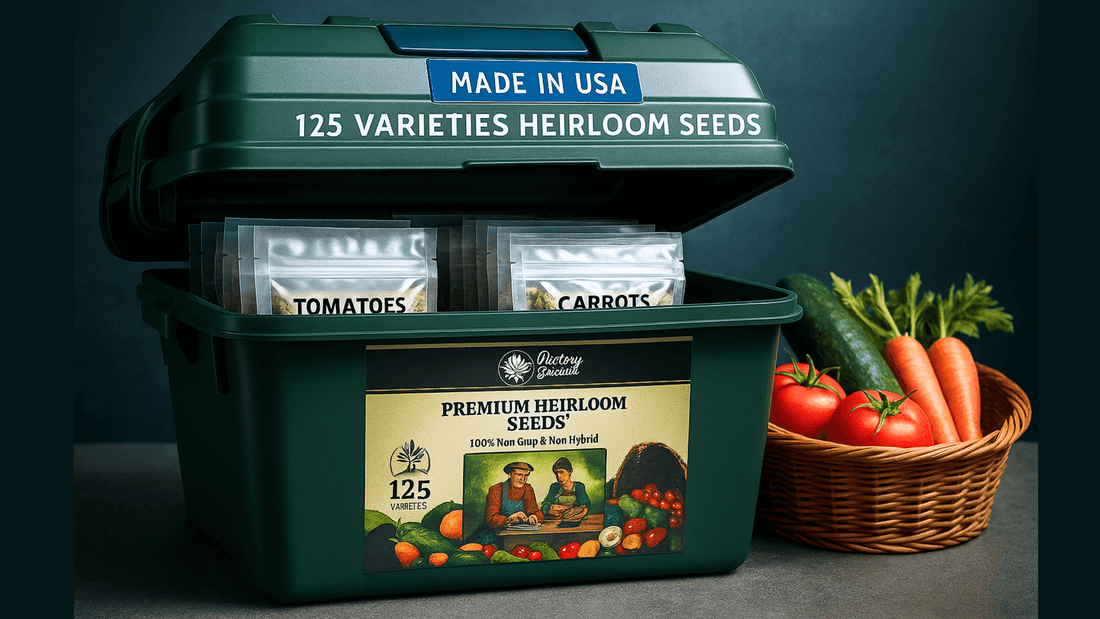There’s something hopeful about holding a handful of seeds. They look so small, yet each one carries the promise of food, security, and independence.
If you’ve ever wondered whether those survival seeds sitting in your pantry are still good—or how long they’ll last if you never need to open them—this is for you. Let’s talk about what really determines seed shelf life, how long you can expect them to stay viable, and how to store them so they’ll still grow strong even years from now.
What Affects How Long Seeds Last
Seeds are living things, even when they look completely still. Inside that hard shell is a tiny plant waiting for the right moment to wake up. The trick is keeping it asleep without letting it die out.
Here’s what makes the biggest difference:
- Temperature: Seeds prefer cool, stable conditions. The lower the temperature (without freezing and thawing often), the longer they’ll last.
- Humidity: Moisture is the real seed killer. A little dampness can spark mold or early germination. Dry seeds are happy seeds.
- Light: Keep them in the dark. Sunlight weakens their outer shell and shortens lifespan.
- Oxygen: Too much air exposure invites moisture and bacteria. Airtight storage keeps that from happening.
- Heirloom seeds, like the ones in the Survival Essentials vaults, have an advantage. Because they haven’t been tampered with genetically, they tend to store better and adapt naturally once planted again.
Average Seed Shelf Life
Some crops are naturally longer-lived than others. Here’s a simple guide you can keep on hand:

If you’re storing them correctly—cool, dark, and dry—these numbers can stretch even longer. I’ve known gardeners who’ve planted 8-year-old beans and still had over 80% sprout.
Seeds That Beat the Odds
One of our long-time customers, Rachel from North Carolina, had a batch of seeds she bought back in 2011. Fourteen years later, after Hurricane Helene, she planted them just to see what would happen.
Read Rachel’s full seed survival story here.
They grew.
Not only did they germinate, they thrived. Those seeds had been through time, storage, and even a hurricane—and still gave her a harvest. That’s the kind of resilience heirloom seeds offer when they’re stored right.
How to Store Seeds So They Last a Decade or More
The good news is you don’t need fancy equipment to do this right. Just a few good habits go a long way.
- Use airtight containers. Mason jars, vacuum-sealed bags, or Mylar packs work great.
- Keep them dry. Add a silica gel packet or even a few tablespoons of dry rice to absorb moisture.
- Store in a cool, stable place. A basement, root cellar, or the back of your fridge are all fine options. If you use the freezer, avoid frequent openings.
Label them. Write down the seed type and storage year so you know what to rotate first.
Consistency is key. The fewer temperature and humidity changes your seeds go through, the longer they’ll stay viable.
Testing Old Seeds Before You Plant
If you’re not sure whether older seeds will still sprout, a quick test can save you time and disappointment.
- Wet a paper towel and lay 10 seeds on it.
- Fold it up and seal it in a plastic bag.
- Keep it somewhere warm (around 70°F).
- Check after a week.
If 7 or more sprout, those seeds are still strong. If fewer do, it’s time to refresh your supply or mix new seeds with the old ones.
Start Your Own Seed Bank
Having your own collection of reliable seeds isn’t just about gardening—it’s about food independence. By keeping a personal seed vault, you’re ensuring your family has the means to grow food no matter what happens in the world.
If you’re just starting out, seed kits like the Survival Essentials Ultimate Heirloom Vault or the 135-Variety Heirloom Kit are perfect foundations. Once you’ve planted and harvested, save seeds from your best plants each year. Over time, your seed bank becomes a living insurance policy—always renewing itself, always ready.
Seeds That Stand the Test of Time
Seeds are small, but they carry immense value. With a bit of care and the right storage, they can stay viable for a decade or longer—ready to feed you, your family, and your community when it matters most.
At Survival Essentials, we’ve seen it ourselves: well-stored heirloom seeds truly stand the test of time. Some have even sprouted after 14 years. That’s the strength of genuine, living seed—it’s built to endure.

